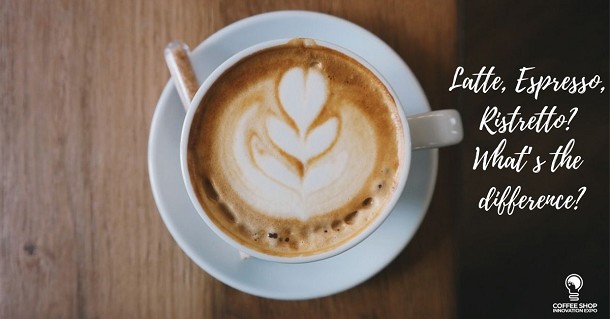Latte, Espresso, Ristretto? What’s the difference?
There’s a legend about Kaldi, a young goat herder who lived around the 6th century in Ethiopia. Once he was in the fields with his herd when he noticed a strange restlessness amongst the goats. Kaldi discovered that his goats were cheerily scoffing down red berries on an unfamiliar branch. So he decided to try some and then he joined the dancing flock and was pronounced the “happiest herder in Arabia”. Some time passed and a passing monk visited the famous goat herder and he soon explained about the berries. The monk had some trouble staying awake during his morning prayers and finally found the answer- when he had eaten the berries he stayed wide awake! It was the Monk's idea to prepare the berries by drying and boiling them to enjoy a drink...
Some time into the far and distant future, we can find ourselves sitting in a coffeeshop sipping on those dried berries... and maybe even doing a little dance too!
Since its humble start, the passion for a good cup of coffee has grown across the globe - and we're long past thinking any brew will do. From bean-origin and tamping, to pour time optimisation, vegan milk, and barista courses, coffee has come a long way.
So we're here to give you the expertise on the coffee we love NOW! Covering everything from espresso to the flat white, we're explaining the make-up of each coffee type, so the next time your customers ask for a ristretto you can serve it up with a smile!
1. ESPRESSO: 30 ml espresso
Everyone’s entry level, an espresso is the definition of pure coffee. Its quantity is the equivalent of a shot. It’s known as the great, the small, bold and expressive: ESPRESSO. To make a decent espresso it’s of the utmost importance that you get a great coffee. Dark roasts are usually more complex as they have caramel and chocolate flavours, so if fruity and floral matches more with your taste then look for the lighter roasts.
Key terms when talking Espresso:
Crema: Whenever you make your espresso, you’ll see the crema on the top. This froth of air bubbles is a result of the pressurization and the oils in the coffee beans. A thicker crema means the bean quality is superior! So, start keeping an eye on the crema while you and try different coffee beans and you’ll soon be a great coffee connoisseur - if you aren’t already!
Demitasse: The espresso cup is named DEMITASSE. Originated in the 1800s in France, it’s the famous 60-90 ml little cup that may look very cute, but it packs a punch! The espresso is usually the most bitter and definitely the most concentrated coffee drink you can buy.
2. DOPPIO ESPRESSO: 60 ml espresso
For the Italian speakers, it’s pretty simple to get what a Doppio Espresso is - given Doppio means Double, Doppio Espresso Coffee is an Espresso x2. A Double Espresso produces from 60 to 70 millilitres of Coffee in 25-30 seconds. Every once in a while, everyone needs an extra dose of energy, so instead of the traditional 30 ml why not make it double? It requires 14 to 16 grams of coffee and it’s extracted through a double portafilter handle. In the early 90’s, Starbucks made the doppio (double shot) a hit in America, even though they were not its inventors. The idea, in the beginning, was to increase the barista’s workflow without affecting much of the coffee flavour.
Does a Doppio Espresso have double caffeine of a usual Espresso?
As we constantly scour the internet to bring you the most accurate information on the coffee industry we (occassionaly!) find that some things are more complicated than they seem. We’ll simplify the answer so you coffee lovers can pass on the information to all of your friends: a single shot of espresso consumes 7 grams of espresso-fine grounds and contains around 30 millilitres of espresso. In the last 80 years, most baristas have had to rely on the naked eye to judge when the espresso quantity was ideal, but recently some baristas have started measuring the exact quantity through weighting the processed coffee. Generally, caffeine comes out very early in the shot, so it doesn’t really matter if you drink just an espresso or a doppio, as either way you’ll be ingesting relatively the same amount of caffeine. Something that can really make a difference is the portafilter...
What is a Portafilter?
The Portafilter is the part of the Espresso Coffee Machine that holds the espresso beans (coffee grounds) before and during the brewing process. It’s where the water goes through and extracts your processed espresso. Many professional baristas consider the Portafilter the most important factor for brewing the perfect coffee. We’ll be going into more details about Portafilters in the future, but for now, it’s important for you to know that they are responsible for how the ground coffee is tamped (compressed), how the pressure will be applied, and the brewing speed.
3. LATTE: 60 ml espresso, 300 ml steamed milk, 2 ml foamed milk
Europe has been consuming Coffee & Milk since the 17th century. Across the globe, this is most commonly referred to as café con leche, milchkaffee, caffé latte, café au lait and so on. When William Dean Howells, an American novelist, went to Italy in 1867, he used the term caffé latte for the first time in an English publication: “The Italian Journeys”, according to the Oxford English Dictionary. It’s also referred to as ‘’wet cappuccino’’ in some regions nowadays. The origin of the word latte comes from Italian, meaning Milk. So be careful if you go to Italy and order a “latte” as you’ll get a simple glass of milk
Cappuccino VS Latte
Many people get confused as they look the same but they’re in fact very different. Depending on the barista, a latte consists of 60ml of espresso, 150ml of frothed milk, and 1 cm of milk foam on top to give that special touch. The frothing of the milk will be done through the steam wand of your espresso machine. It’s very common for beginners to get confused between café lattes and cappuccinos. The major difference is that cappuccino consists of 1/3 espresso, 1/3 steamed milk and 1/3 foamed milk. So, if you’re a foam lover, go for the cappuccino - if you’re a liquid lover, definitely go for the Latte!
Lactose-Free and Vegan Milk Options
Until most recently, many vegan and lactose intolerant coffee lovers would have been disappointed about having to give up on their favourite drink as there were no other dairy-free alternatives. Happily, increasingly more and more companies are aware of this and are doubling their efforts to find new ways to supply to this new, ever-growing market.
The number of plant-based milk brands is rising every day. Here are some of the top alternatives which are sure to satisfy your cravings from here on in:
1. Almond Milk
2. Oat Milk
3. Coconut Milk
4. Pea Milk
5. Rice Milk
6. Soy Milk
7. Quinoa Milk
8. Hemp Milk
Find out more about choosing the perfect plant-based milk for a true barista expereince here.
4. FLAT WHITE - 60 ml espresso, 120 ml steamed milk
The cute flat white is very similar to cafe latte, the main difference is down to the size given the flat white is smaller. Consequently, it’s also more concentrated, as there is less milk which means it has a higher rate of pure coffee. If you want to reduce the chances of your coffee being ruined by too much milk, then the flat White is highly recommended over the latte.
A flat white is usually served in a ceramic cup. The milk is frothed just like a latte but its height is reduced to 20mm.
5. RISTRETTO: 22 ml concentrated espresso
It's all about the ratio! Ristretto meaning ‘shortened’ is traditionally a smaller shot of espresso and uses a finer grind of the beans. The concentration is an extremely important part of ristretto extraction, as a shorter shot has darker umbers whereas the end of a shot is a much lighter tanned tone.
When is the best time to have a Ristretto?
If you need a quick and strong boost you should definitely go for a ristretto. It’s the famous emergency button in the coffee world. If you’re not used to it, start with the lungo or espresso instead.
6. LUNGO: 60 ml less concentrated espresso
The opposite of ristretto, lungo means ‘long’. It’s made by using espresso machines with much more water (usually twice an espresso dose).
How long does it take to make a lungo?
Essentially, it’s the same process as an espresso, but it just takes longer. To get started, use your espresso machine and remember to get more water in there! It may take up to a minute to pull around 60 millilitres, differently to espressos which usually take from 18 to 30 seconds to pull the usual 30ml. There’s no exact definition of what the size of a lungo must be, but the consensus is anywhere between 2 to 4 times more quantity than a usual 30ml espresso.
Does an Espresso have more caffeine than a lungo?
A typical question often posed by caffeine lovers - we tend to think that because there’s more water the nutritional value lowers, but this is not true. The same amount of caffeine that espresso contains is also in a coffee lungo. The only difference between them is the water amount and processing time. What could influence the concentration of your coffee is the type of beans you use. If you want a lower concentration, go for Arabica beans - but if you’re looking to gain energy, and enjoy a more intense flavour, you should definitely choose Robusta beans.
7. MACCHIATO - 60 ml espresso, dot of foamed milk
A Macchiato, commonly known as an Espresso Macchiato, is simply an espresso with a dash of foamed milk.
The key to the perfect Macchiato
The key is in the detail when it comes to making the perfect Macchiato - getting the ratios just right can make or break the flavour. As previously mentioned, a Macchiato should contain just a splash of foamed milk, if too much is added you’ll end up with something that resembles more of a latte or cappuccino.
What are the different types of Macchiato?
It’s fair to say that ordering the right coffee can be pretty overwhelming what with the plethora of options - so here’s the main 3 Macchiatos broken down. A Caffe Macchiato and an Espresso Macchiato are both traditional versions of the Macchiato which are made from a shot of espresso paired with a spot of lightly frothed milk. A Latte Macchiato on the other hand is a blend of a macchiato and a milky latte.
8. CAFÉ NOISETTE - 60 ml espresso, 30 ml steamed milk
On the topic of espressos with a dash of milk, we have the Cafe Noisette. What sets it apart from the Macchiato is that the milk is steamed instead of foamed - this is then either poured in by the Barista or served in a smaller pot for the consumer to pour.
How did the Cafe Noisette get its name?
The Cafe Noisette originated in France and the term ‘noisette’ is French for ‘hazelnut’ which relates to the drink’s hazelnut colour.
9. CAPPUCCINO - 60 ml espresso, 60 ml steamed milk, 60 ml foamed milk
The Cappuccino is one of the most popular forms of coffee, but don’t get it confused with a latte! Although they both combine the same ingredients, the ratios are very different. A typical Cappuccino is split evenly into thirds - ⅓ espresso, ⅓ steamed milk and ⅓ foamed milk to create a rich and airy taste.
Why are Cappuccinos so popular?
Europe has always been one of the biggest fans of the Cappuccino, particularly in Italy where they regularly drink it as part of their breakfast routine. The craze spread across Britain quickly as Brits were already used to adding milk to their coffee, but this new concoction had a distinct texture which set it apart from normal coffee. It is looked at as a ‘fancy beverage’ which can usually only be made properly in cafes due to the skill and machines needed to get its precise ratios right - hence why so many people go to coffee shops to order them.
10. DRY CAPPUCCINO - 60 ml espresso, 60 ml foamed milk
Think of a regular Cappuccio, but with less steamed milk and more foam. Voila - you have a Dry Cappuccino. This is usually a lot less creamy and sweet as the espresso is more concentrated.
How many ways can I have a Dry Cappuccino?
Although the recipe is simple, there are actually many ways to enjoy a Dry Cappuccino. For example, you could ask for a Bone Dry Cappuccino - which is just espresso and foam without any steamed milk. Or to mix it up a bit, why not choose a different kind of milk to slightly alter the taste, texture or flavour? You could choose skimmed, 1 percent, 2 percent or whole milk, eggnog, or perhaps vanilla soy milk or almond milk. Along with an array of milk choices, you can then choose different sweeteners, flavours and toppings, just to make your order a little more complex.
11. AMERICANO - 60 ml espresso, 90 ml hot water
The Americano is simply espresso and hot water. The ratio of these is usually either half and half or ⅓ espresso, ⅔ hot water, depending on the barista or your preference.
How was the Americano invented?
The origin of the Americano is said to have begun during World War II. Apparently the American soldiers who were stationed in Italy found the Italian espresso too strong, and so they added hot water to make it taste more like the coffee they were used to back home - thus the Americano was born.
The water vs espresso first debate
Considering the Americano is only made from espresso and hot water, you’d think there wouldn’t be much debate in how it was made, right? Wrong! The water vs coffee first debate is quite a strong topic in the coffee community when it comes to the Americano, with large groups voting for both sides. However, the vote generally leans toward putting the espresso in first, followed by the hot water.
12. AFFOGATO - 60 ml espresso, 90 ml vanilla ice cream
Simple, yet so fulfilling, the Affogato is a delicious espresso dessert originally born in the 1990’s. An Affogato, which literally means “drowned” in Italian, is made from the combination of hot espresso poured over vanilla ice cream.
When is the best time to have an Affogato?
An Affogato is the perfect answer to the post-meal coffee or dessert dilemma. It is also a great way to give you that late afternoon energy boost.
What extras can I add to an Affogato?
There are lots of ways to dress up your affogato to deviate from the classic, for example adding an alcoholic beverage is a cheeky twist. We’d suggest either Amaretto or a dessert wine like Port. If you want to make it extra fancy, try adding some dried berries, almonds, honeycomb or biscuit crumbs.
13. MOCHA - 60 ml espresso, 50 ml chocolate, 30 ml steamed milk
The Mocha gets its name from its coffee beans which originated in Mocha, Yemen. These coffee beans have a natural chocolate flavour, however baristas add a little chocolate to the recipe to enhance the sweet flavour.
Variations of Mocha
When ordering a Mocha, you may come across the terms mocaccino, mochaccino, mochachino or caffè mocha - these are all just spelling variations of the Mocha. Mochas can be served with frothed milk on top, or sometimes with whipped cream instead. There is also usually an option to add a cinnamon or cocoa powder dusting on top, and marshmallows for decoration.
14. CAFÉ CON HIELO - 50 ml espresso, ice cubes
Haven't heard of this one before? Just think of a smaller, stronger iced coffee. Cafe Con Hielo literally translates to ‘coffee with ice’ in Spanish and consists of an espresso shot, or double espresso shot, poured over ice for a refreshing, typically Summer, beverage.
What’s the difference between an iced coffee and a cold brew?
Although both essentially cold coffees, there are some big differences between the cold brew and iced coffee, these can simply be defined as:
Cold Brew: Made using cold water, less bitter & less acidic.
Iced Coffee: Made with hot water, more bitter & more acidic. It also generally costs less than a cold brew.
15. CON PANNA - 60 ml espresso, 90 ml whipped cream
Stuck between enjoying a coffee or dessert after your meal? You can have both with an Espresso Con Panna! Essentially, this delicious drink is a shot (or two) of espresso with a big dollop of whipped cream on top - perfect for any sweet tooth craving!
What’s the best way to enjoy an Espresso Con Panna?
It is said that the Espresso Con Panna originated in Italy, as the name means ‘espresso with cream’ in Italian. For the best taste, it is not only important to ensure you‘re using the best quality coffee beans, but the best cream too. None of that whipped cream from a can business; real, hand-whipped cream is the perfect cherry-on-top of your espresso.
Next Read: Finding The Best Plant-Based Milk For Barista Style Coffee










